Last Updated on May 11, 2022 by Kittredge Cherry
A queer Lutheran artist launched a new series of Queer Saints icons recently.
Traditional saints with queer qualities and heroes of the LGBTQ community are presented with rainbow halos by seminarian Katy Miles-Wallace in her colorful “Queer Saints” series.
Miles-Wallace is a student in her final year at Pacific Lutheran Theological Seminary in Berkeley, California. She currently serves on internship in Dublin, Ohio outside of Columbus.
Her icons are rooted in queer theology and in an eclectic faith journey that began at a Baptist church in south Texas. She drew many of them on the altar of a seminary chapel.
Miles-Wallace has completed at least seven icons since she began the diverse series in spring 2017. Traditional figures in her collection include Biblical same-sex couples David & Jonathan and Ruth & Naomi, paired female saints Perpetua & Felicity and gender-transgressing saint Joan of Arc. She also created icons of revered secular LGBTQ figures such as rainbow-flag creator Gilbert Baker and gay martyr Matthew Shepard. So far one icon comes from the contemporary LGBTQ Christian movement: gay preacher and theologian Peter Gomes.
Their rainbow haloes respectfully depict their potential or confirmed sexual orientation or gender identity and how it informed their spirituality.
Miles-Wallace is continuing to create new icons and add them to her website and her online shops at Zazzle and Etsy, where they are available as prints, jewelry, puzzles, phone cases and other items. She specializes in “art at the intersection of LGBTQIA+ identities and Christianity.”
Her growing list of “saints that are on my radar” ranges from Francis of Assisi and Jesus with the Beloved Disciple to more modern figures who are not yet recognized by the church. These soon-to-be icons include 9/11’s gay chaplain Mychal Judge, same-sex marriage plaintiff Edith Windsor, Stonewall rioter Marsha P. Johnson and queer Latina theologian Marcella Althaus-Reid.
Miles-Wallace discusses her artistic process, spirituality journey and the queer theology behind her innovative icons in the following interview with Q Spirit founder Kittredge Cherry.
Interview with Queer Saints artist Katy Miles-Wallace
Kittredge Cherry: Why did you decide to create icons of queer saints?
Katy Miles-Wallace: In all honesty, this wasn’t an altruistic decision about how I might change the world. It started out as a way to get out of writing a long paper in a seminary course. My “Luther on Freedom” professor, Rev. Dr. Kirsi Stjerna, knew that I was an artist as I had done some icons before and told me that doing a series of icons and a short paper would be sufficient for our term paper/project. I had also just completed a semester project studying LGBTQIA+ inclusivity in the Evangelical Lutheran Church in America and was on a roll. It was a purely selfish choice and something that I thought, secondarily, might be a cool thing to put on a wall or give away. Funnily enough, QSpirit.net was one of the places that I did a lot of my research on queer saints and their representations.
Kittredge Cherry: No wonder I feel a kinship between your icons and my website! When did you begin the Queer Saints series?
Katy Miles-Wallace: My seminary memories bleed together a little bit but I want to say that I started the original collection in mid-April of 2017. I spent a lot of time in the seminary chapel with music blaring over the sound system as I worked away on these icons. I actually did most of them on the altar in the chapel.
Kittredge Cherry: What process do you use to research and create a queer saint icon?
Katy Miles-Wallace: My process is much more “modern” than traditional iconography. Initially I was just choosing figures who were important to me in some way or important to friends. I had an initial list of about 21 and chose to work on Saint Joan of Arc, Gilbert Baker, Matthew Shepard, Peter J. Gomes, and Naomi and Ruth. So, I select a saint whether they be modern or traditional and I begin to really immerse myself in their history, trying to pick up on imagery or things that really marked their lives. This involves hours on the internet. I then find an image that I feel embodies the person well and work off of that as reference. Some are particularly iconic, for instance more recent people like Gilbert Baker and Edith Windsor and so I might use a projector to get a closer likeness. Others, like Sor Juana Ines de la Cruz, who we don’t have photographs of, I look to other artists’ likenesses and work off of those to create my own.
In terms of physical creation, I usually work on Bristol board, drawing my outlines in pencil and then coming back with Prismacolor colored pencils and a wax blending pencil to smooth things out. The coloring process is what becomes contemplative for me. This is contrary to the standard egg tempera on wood approach that has historically been used, mostly due to having had mastery of colored pencil to finish the initial project on time. I have a few people that I tend to check in with throughout the process and ask whether things look good or if my thoughts on colors make sense. If it’s made for someone in particular I actually start with an interview with the person about what makes the saint important to them and what characteristics that they would like to see shine through in the artwork.
Kittredge Cherry: One of the most radical and unique aspects of your Queer Saints collection is that they all have rainbow halos. Can you explain the theology behind that?
Katy Miles-Wallace: The rainbow halos are another child of necessity, so to speak. I was trying to figure out how to mark these icons as specifically of queer saints. I didn’t want the backgrounds to be rainbow because that seemed to ostentatious and I didn’t want to put some sort of logo on them that might mar the artistic quality of the image. So, the idea struck me to incorporate a rainbow into the halo. The arc is the same as a natural rainbow anyway, though in mine the colors are vertical rather than horizontal. Theologically, I think this imparts the way that sexuality is holy and that how particularly non-heteronormative identities can inform a person’s life and faith that it becomes absolutely integral to their saintliness. Thus, these are not just holy people, but people whose bodies and identities bear witness to God beyond their actions. I also really love the symbolism of the rainbow covenant and the way that it intertwines with queer identity and the idea that we are the rainbow people with whom God also has a covenant. It’s Biblical!
I’m still experimenting a bit with the halos and have a commission for a Jonathan and David with a bi-pride halo that I’m working on. We’ll see how it turns out and whether I stick with rainbows or dip into identity specific halos.
Kittredge Cherry: Now that you have made at least seven Queer Saints icons, what did you experience and learn through the process of creation?
Katy Miles-Wallace: Well, I’ve obviously learned a lot about the saints that I’ve researched. I think though that creating icons is not so much an intellectual pursuit as it is an exploration of the self, the saint, and the other in their reactions to the work. I’ve learned that my talents are more valuable than I thought, that where I see lines and mistakes others are seeing the divine and potentially even themselves entangled with divinity. I’ve learned that iconography can be more than just a tool for worship of God but also a tool for journeys of self-understanding. I have a trans friend who has mentioned that my icon of Joan of Arc in particular (modelled on androgynous model Rain Dove), has helped them to better understand their own gender identity.
I also think that sinking into the lives of these saints and knowing that probably not all of them would identify as Christian (I’m particularly not sure if Gilbert Baker did), has shown me the importance of representation in art and media and the way that being surrounded by the cloud of witnesses, when there are some who also look like you, can make you feel at home in a faith which has historically harmed LGTBQIA+ people.
Kittredge Cherry: Your online bios say that you are a queer Lutheran seminarian and “soon-to-be-pastor.” What is your own spiritual journey?
Katy Miles-Wallace:My spiritual journey is not incredibly complex but one that I think is a bit odd. I spent my early years as a Baptist in South Texas. My family stopped consistently going to church when I was around 6 and so I stopped going but hung out with a lot of the same friends and families. I started to lean away from the church and moved schools and was really beginning to ponder God and creation when I decided to become a Fellowship of Christian Athletes captain at my middle school. Then I ran far away and decided that I hated organized religion.
This was all while I was determining my own sexuality and that isn’t easy in South Texas or in the Baptist Church at the time. So, I was one of the famed “spiritual but not religious” folks throughout high school and into the beginning of college. By a series of clearly Spirit-led circumstances I landed at Texas Lutheran University under campus pastor Rev. Greg Ronning and fell in love with liturgy and with this welcoming way of being the church. I was also taking theology courses with Rev. Dr. Norm Beck who encouraged us and would take us to go and worship with Hindus and Buddhists and Jews and I found that I was worshipping the God of Abraham but in different rituals and languages.
I met my wife who is a confirmed Lutheran and she took me to an Ash Wednesday service (a service I had never attended before) and I fell in love with it. I begged her to go back again the next year and I watched Rev. Dr. Harry Foster put ashes on the head of an infant with tears rolling down his cheeks as he proclaimed “You are dust and to dust you will return.” When I walked out of the service I said, “I want to be a pastor,” and she said “Talk to Pastor Greg.” A few weeks later I was baptized and confirmed a Lutheran, began attending Spirit of Joy Lutheran Church in Seguin, Texas and started my candidacy paperwork. In seminary though, I really discovered process and queer theology which informs much of my way in the world and intellectual process in selecting saints.
Kittredge Cherry: Are you openly LGBTQI+ yourself? How does your identity influence your art and faith?
Katy Miles-Wallace: I am! In the past I’ve identified as an out and proud lesbian woman, though have begun to take on “queer” as an identity the more I understand myself as non-binary in gender. I really think that it’s hard for an artist to have an art if they don’t have an identity. It so much informs how I think and how I create and how I am faithful. It influences my art in that what I’m doing is genuinely for the benefit of other rainbow folks like me, not as a savior but as a sibling. And, with how expressive art is I feel like it’s important for queer people to do queer art. I think there’s an authenticity in it.
As for my faith, I think all LGBTQIA+ people, really all minority people, have a unique perspective on crucifixion and resurrection. Especially out LGBTQIA+ people who know what it means to dwell in the tomb/closet and be free. We get it in a way that cis hetero folks can’t.
Kittredge Cherry: How do people respond to your icons of queer saints? Have they led to any hateful comments, controversy or censorship?
Katy Miles-Wallace: I have actually not run into a single ugly comment so far. I do other liturgical art that has been really highly praised and when I mention the queer saints they can tend to get ignored but that has been the worst of it. Mostly people have told me how meaningful the art is and how it is often a celebration of LGBTQIA+ identities in the church that they haven’t seen before. If anyone has an issue they haven’t made it known!
Kittredge Cherry: Which queer saint will you do next? And what are your future plans for the Queer Saints series?
Katy Miles-Wallace: I have a huge and growing list on my website. I do have a group in process including Marcella Althaus-Reid, John Boswell and Mary Magdalene: Sibling of All Queer Crucified. I’m also working on a couple of private commissions, namely a bi-pride version of Jonathan and David. Right now I plan to keep going! I’m currently taking commissions and selling prints. I’m also open to suggestions for more and different saints. I have expanded the Queer Saints series into my Queerly Christian brand which is a combination of art, merchandise, and (soon) liturgy resources. I’ve just posted a Queer Christian Creed and hope to add some more things like naming rites and blessing of nontraditional relationships.
Kittredge Cherry: I’d like to share more of your icons with my profiles in the future and send you occasional suggestions for queer saints to draw. Are you open to that?
Katy Miles-Wallace: I’d love for you to send suggestions and to use more of my work. It seems that we have a sort of natural relationship that’s formed between our projects and I dig it.
___
Top image credit: “David and Jonathan” by Katy Miles-Wallace. This and other LGBTQIA+ Christian icons by Miles-Wallace are available from her website and the Queerly Christian shops at Zazzle.
___
This post is part of the LGBTQ Saints series by Kittredge Cherry. Traditional and alternative saints, people in the Bible, LGBT and queer martyrs, authors, theologians, religious leaders, artists, deities and other figures of special interest to lesbian, gay, bisexual and transgender and queer (LGBTQ) people and our allies are covered.
This article was originally published on Q Spirit in 2018 and was updated for accuracy on May 11,2022.
Copyright © Kittredge Cherry. All rights reserved.
Qspirit.net presents the Jesus in Love Blog on LGBTQ spirituality.
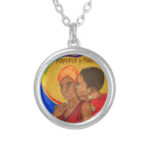
LGBTQIA+ Christian saints, canonized and modern, are available as prints, jewelry and more at the Queerly Christian Zazzle shops
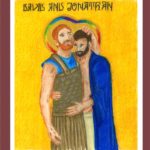
David and Jonathan and other LGBTQIA+ Christian saints are available as prints, jewelry and more at the Queerly Christian Zazzle shops

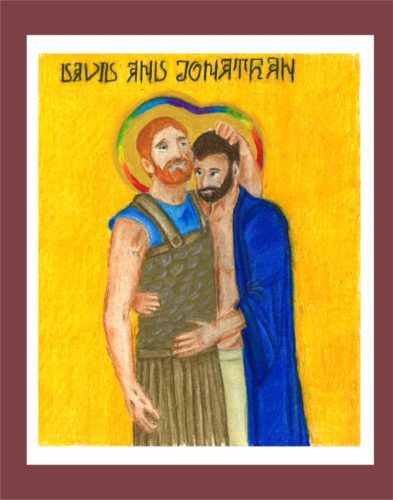
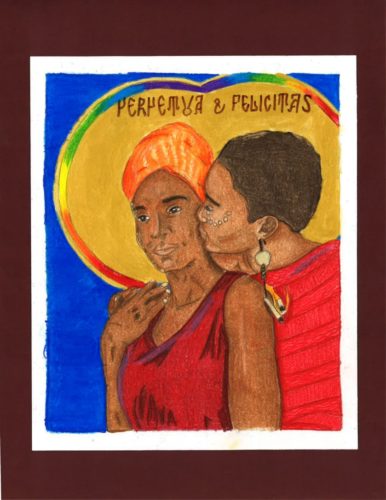
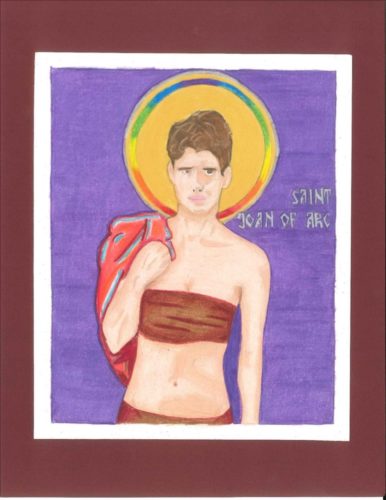
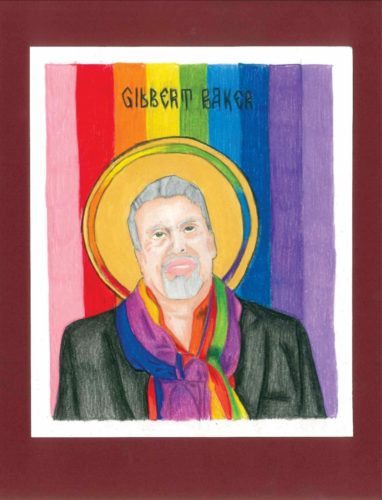






The icon of Joan of Arc absurdly shows her as virtually the opposite of how the historical Joan of Arc was described by eyewitnesses: e.g. it shows her as looking androgynous whereas her bodyguard, Jehan d’Aulon, said she was “beautiful and shapely”; and it shows her with the typical chest-binder (to make her look transgender) whereas the Duke of Alencon said that her breasts were prominent enough for the shape to be clearly noticeable even with a soldier’s tunic on. And of course, she always called herself “the maiden” (“la pucelle”) rather than identifying as male or non-binary, and there are quotes from her and from eyewitnesses explaining the practical need to wear soldier’s clothing (“male clothing”) both during her military campaigns and in prison, where she kept it laced together securely to hinder her guards from pulling her clothing off when they tried to rape her.